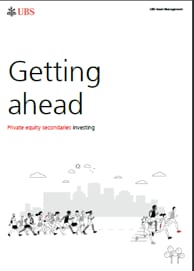Private Equity Secondaries - Is now the time?
Investment opportunities with this private equity sub-asset class

![]()
header.search.error
Investment opportunities with this private equity sub-asset class
Secondary sellers are motivated and asset pricing, valuations and quality have improved.
Jochen Mende, Head of Secondaries

Is now the time?
The market for private equity secondary transactions has boomed in recent years. Estimated transaction volumes set a record in 2021 at over USD 130 billion, and volumes in the first half of 2022 are estimated at USD 55-58 billion, yet another record1.
Back to basics: what are private equity secondaries?
In a typical secondary transaction, a buyer acquires private equity assets from an investor (LP) or as part of a so-called GP-led transaction. Thus, everything that happens on the secondary market is a function of what happened on the primary fundraising market in the past, say 5-6 years.
Private equity funds raised ca. USD 4.7 trillion between 2017 and November 2022. As most of these funds are closed-ended, there is no built-in liquidity mechanism for investors. And in case investors’ circumstances change (which over the typical 10+ year life of a fund happens a lot!), the only option to get liquidity is the secondary market
There is no shortage of potential supply for the secondary market
Preqin estimates private equity assets under management to be at USD 8.7 trillion at the end of March 20222 – quite a ‘target rich environment’ for buyers.
As far as potential market volume is concerned, the most optimistic estimates we are aware of, quite confidently predict USD 1 trillion per annum by 2030. In our view, availability of capital and talent to transact these volumes will be limiting factors. For example, Jefferies estimate that there was ‘merely’ USD ~100 billion3 in dedicated equity dry powder available for secondaries as per 2Q22.
So what’s happening right now?
LPs are motivated to right size their private equity portfolios to remain in compliance with their strategic asset allocation as public markets have declined YTD224. Further, private equity as an asset class appears to have turned net cash flow negative in 2022: for example, Preqin estimate aggregate deal values exceeded buyout exit activity by ca. USD 270 billion2. Lastly, as many highly sought-after GPs have come back to investors for fundraising faster than expected, investors are managing their portfolios more actively. GPs will turn to the secondary market as an alternative liquidity source, especially when traditional exit paths are either blocked or do not deliver the desired returns.
How will private equity secondaries fare in the current environment?
In our own experience, the quality of our deal flow is much improved compared to 2H21. We see fewer fishing expeditions and tail-ends on the LP-side. Conversations on pricing have also become more realistic and discounts – even for good quality assets – are achievable. However, it’s important to keep in mind that private equity valuations typically lag public market valuations by a couple of quarters. Therefore, a discount to a 4Q21 valuation might quickly erode. On the GP-led side, asset and GP quality are generally high, and proposed terms on asset pricing and GP incentivization overall feel more LP friendly than a year ago.
Learn more about Secondaries in our white paper:

Getting ahead
All you need to know about investing in Private Equity Secondaries.